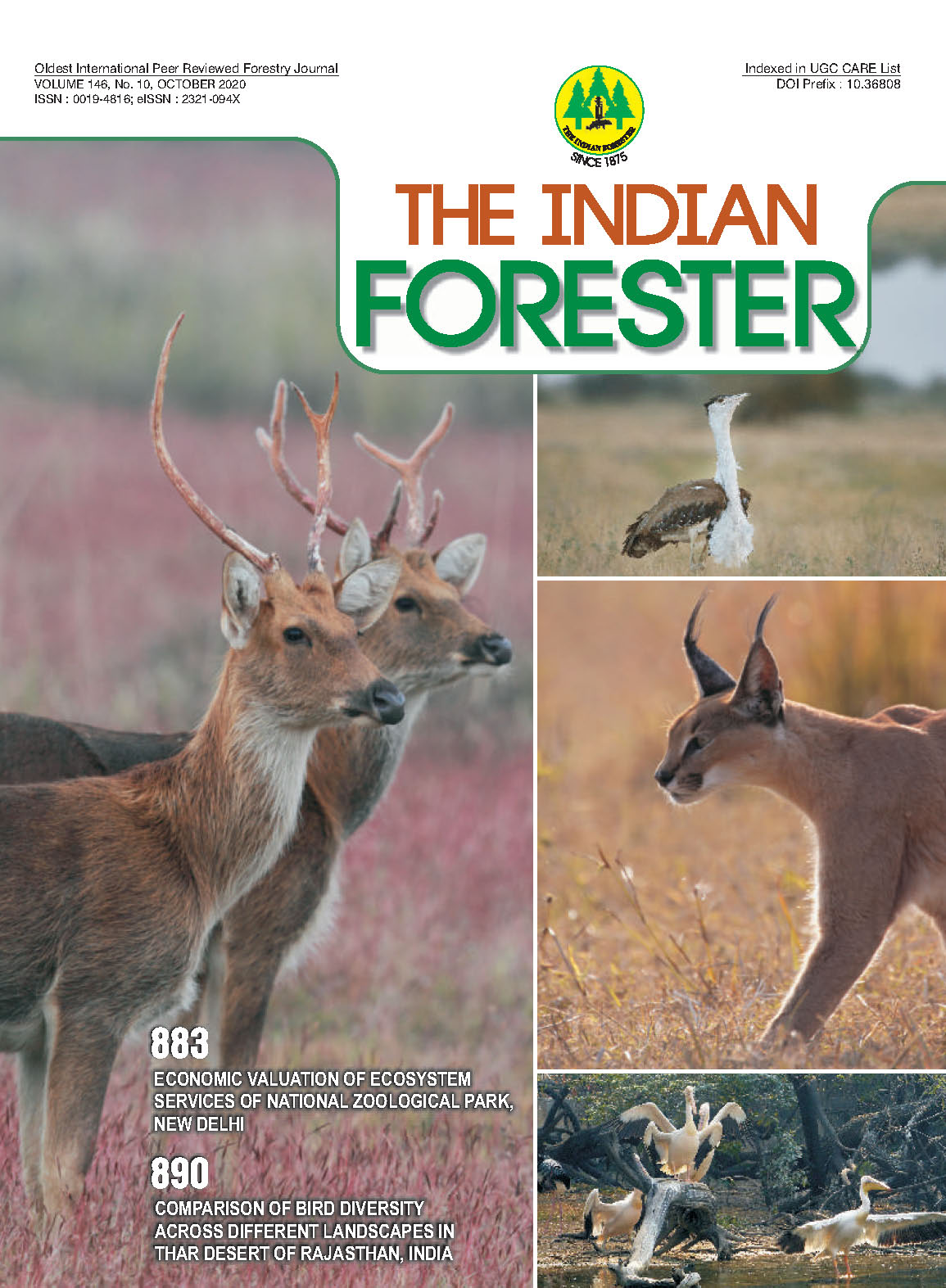Habitat Utilization by Indian Peafowl, Pavo cristatus (Phasianidae), in Indroda Nature Park, Gandhinagar, Gujarat, India
DOI:
https://doi.org/10.36808/if/2020/v146i10/155436Keywords:
Indroda Nature Park, Indian Peafowl, Behavioural activities, Activity Budget.Abstract
The behavioural activities of the Indian Peafowl (Pavo cristatus) from the various environments oflndroda Nature Park (INP), Gandhinagar, Gujarat was evaluated based on the Activity Budget method. It was inferred that Indian Peafowl utilize the INP for all m ajorbehavioural activities. However, maximum time was spent for foraging activity followed by resting activity. The study has also brought out that Botanical Garden and Campsite of lNP were utilized for all requisites. These areas were observed to be suitable forresting as they are covered with tall trees.References
Ali S. (1996). The Book oflndian Birds. Bombay Natural History Society, Oxford University Press, Mumbai.
Ali S. and Ripley S.D. (1980). Handbook of the birds oflndia and Pakistan (2nded.). Oxford University Press, pp. 123-126.
Bird Life International (2016). Pavo cristatus. The IUCN Red List ofThreatened Species 2016: e.T22679435A92814454.
Borad C.K. and Parasharya B.M. (2018). Conservation of Indian peafowl in agricultural landscape. International Journal ofFaunaandB iologicalStudies ; 5(2): 108-113.
Brickie NickW. (2002). Habitat use, predicted distribution and conservation of green peafowl (Pavo muticus) in Dak Lak Province, Vietnam. Biological Conservation, 105: 189-197.
Harikrishnan S., KarthikeyanVasudevan and SivakumarK. (2010). Behaviour of Indian Peafowl Pavo cristatus Linn. During the Mating Period in a Natural Population. The Open OrnithologyJournal, 3: 13-19.
Harrison M.E., Vogel E.R., Morrogh-Bernard H.C. and Noordwijk M.V. (2009). Methods forcalculating activity budgets compared: A case study using Orangutans. American Journal ofPrimatology, 71: 353-358.
Jackson C. (2006). Peacock. London: Reaktion Books LTD.
Johnsingh A.J.T and Murali S. (1978). The ecology and behaviour of the Indian Peafowl (Pavo cristatus Linn.), Indian Journal of Bombay Natural History Society, 75(3): 1069-1079.
Johnsingh A.J.T. (1976). "Peacocks and cobra". Indian Journal ofBombay Natural History Society, 73(1): 214.
Kannan R. and James D.A. (1998). Indian Peafowl (Pavo cristatus), version 2.0. In The Birds of North America (A. F. Poole and F. B. Gill, Editors).Cornell Lab of Ornithology, Ithaca, NY, USA.
Kushwaha S. and Kumar A. (2016): A Review on Indian Peafowl (Pavo cristatus) Linnaeus. Journal of Wildlife and Research, 4: 42-59.
Mohanty S.K. (2010). Environmental PollutionLaws. Universal Law Publishing. New Delhi pp. 853.
Parashrya B.M. and MukerjeeA. (1999). Roosting behaviour of Indian Peafowl Pavo cristatus. Journal ofBombayNatural HistorySociety, 96(3): 471-472.
Pathak B.J. and Kamboj R.D. (2016).Indroda Nature Park, MasterPlan (2016-17 to 2025-26),Gujarat Ecological Education and Research (GEER) Foundation.
Rajeshkumar N. and Balasubramanian P. (2012). Habitat use and food habits of Indian Peafowl Pavo cristatus in Anaikatty Hills, Western Ghats Indian Birds, 7: 125-27.
Ramesh K. and McGowan P. (2009). On the current status of Indian Peafowl Pavo cristatus (Aves: Galliformes: Phasianidae): keeping the common species common. Journal ofThreatened Taxa, 1(2): 106-108;
Trivedi P. and Johnsingh A.J.T. (1995). Dietoflndian Peafowl Pavo cristatus Linn.inGir Forest, Gujarat. J. BombayNat. Hist. Soc., 92 (2): 262-263.
Trivedi P. (1993). Habitat selection by Indian Peafowl (Pavo cristatus Linn) in Girforest, India. M.Sc. Dissertation, Saurashtra University.
WaltherB.A. and Clayton D.A. (2005). Elaborate ornaments are costly to maintain: evidence for high maintenance handicaps. BehaviourEcology, 16: 89-95.
Downloads
Downloads
Published
How to Cite
Issue
Section
License
Unless otherwise stated, copyright or similar rights in all materials presented on the site, including graphical images, are owned by Indian Forester.





